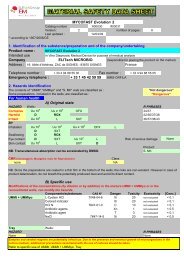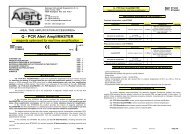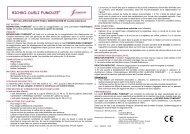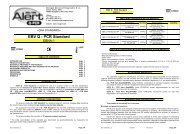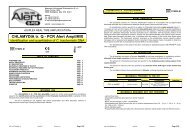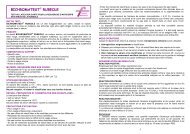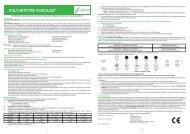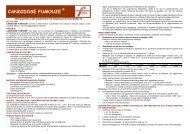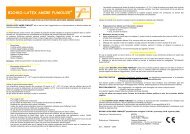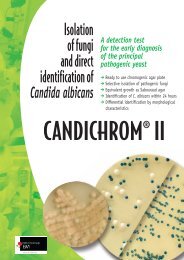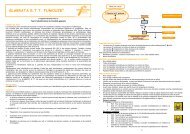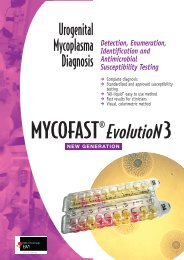Package insert
Package insert
Package insert
You also want an ePaper? Increase the reach of your titles
YUMPU automatically turns print PDFs into web optimized ePapers that Google loves.
HSV2 Q - PCR Alert AmpliMIXdetection and dosing of HSV2 DNARTS032-MHSV2 Q - PCR Alert AmpliMIXdetection and dosing of HSV2 DNARTS032-MAmplification set-up(To be performed in the extraction/preparation area of the amplification reaction)Before starting the session it is important to do the following:- remove and thaw the test tubes containing the samples to be analysed. Centrifuge the tubes tobring the contents to the bottom and keep in ice;- remove and thaw the AmpliMIX test tubes needed for the session, remembering that the contentsof each tube are sufficient for 24 reactions. Centrifuge the tubes for 5 seconds to bring the contentsto the bottom and keep in ice;- remove and thaw the same number of test tubes of AmpliPROBE as the AmpliMIX tubes.Centrifuge the tubes for 5 seconds to bring the contents to the bottom and keep in ice;- remove and thaw the same number of test tubes of AmpliMASTER as the AmpliMIX tubes. Write"HSV2" and the date on the test tube labels using indelible ink. Centrifuge the tubes for 5 seconds tobring the contents to the bottom and keep in ice;remove and thaw the Positive Control test tube or the Q - PCR Standard tubes. Centrifuge thetubes for 5 seconds to bring the contents to the bottom and keep in ice;- if necessary, cut the amplification microplate to separate the part that will be used in the session,being careful to handle it with powder-free gloves and not to damage the wells.1. Transfer 100 µl of AmpliMIX to the AmpliMASTER tubes. Mix well and pipette the volume of 100 µlthree times into the mix.2. Transfer 100 µl of AmpliPROBE to the AmpliMASTER tube. Mix well and pipette the volume of 100 µlthree times into the mix.3. Vortex on a low setting for 5 seconds, avoiding the creation of foam.4. Centrifuge the tubes for 5 seconds to bring the contents to the bottom.5. Carefully deposit 20 µl of the reaction mixture obtained in this way on the bottom of the amplificationmicroplate wells, as previously established on the Work Sheet.N.B.: If not all the reaction mixture is used, store the remaining volume in the dark at -20°C for a maximu m ofone month in the test tube labelled "HSV2". Freeze and thaw the reaction mixture ONLY ONCE.6. Carefully deposit 5 µl of DNA extracted from the first sample in the reaction mixture in thecorresponding well of the amplification microplate, as previously established on the Work Sheet.Proceed in this way for all the other DNA extracts.7. Carefully deposit 5 µl of sterile bidistilled water (not supplied with the product) in the reaction mixturein the well of the negative control amplification microplate, as previously established on the WorkSheet.8. Gently deposit 5 µl of Positive Control in the reaction mixture in the corresponding amplificationmicroplate well, as previously established on the Work Sheet.N.B.: When this product is used for dosing HSV2 DNA, carefully deposit 5 µl of Q - PCR Standard 10 2copies in the reaction mixture in the corresponding amplification microplate well as previously establishedon the Work Sheet. Proceed in this way for the other Q - PCR Standard (10 3 , 10 4 , 10 5 copies).9. Carefully seal the amplification microplate using the amplification adhesive sheet.10. Transfer the amplification microplate to the real-time thermal cycler in the amplification/detection areafor amplification products and start the thermal amplification cycle.Interpreting the resultsThe values recorded of fluorescence emitted by the specific probe for HSV2 (FAM fluorophor) and bythe specific probe for the beta globin (VIC fluorescence) in the amplification reactions must be analysed bythe software.Before analysing, it is necessary to:- referring to the instrument documentation, manually set the calculation range for the fluorescenceback ground level (Baseline) from cycle 6 to cycle 15*;*N.B.: In the case of a positive sample with a high titre of HSV2, the FAM fluorescence of the specific probefor HSV2 may begin to grow before the 15th cycle. In this case the calculation range for the baseline must beadjusted from cycle 6 to the cycle in which FAM fluorescence starts to grow, e.g. cycle 10.- referring to the instrument documentation, manually set the threshold for FAM fluorescence to 0.2;- referring to the instrument documentation, manually set the threshold for the VIC fluorescence to0.1.The values of fluorescence emitted by the specific probe for HSV2 in the Positive controlamplification reaction and the Threshold value of fluorescence are used to validate amplification anddetection as shown in the following table:HSV2 Positive controlThreshold cycle (FAM)Assay resultAmplification / DetectionDetermined POSITIVE CORRECTIf the result of the Positive control amplification reaction is Undetermined, it means that targetDNA has not been detected. A problem has occurred during the amplification or detection phase (incorrectreaction mixture volumes, probe degradation, positive control degradation, incorrect dispensing of positivecontrol, incorrect positive control position setting, incorrect thermal cycle setting) which may cause incorrectresults. The session is invalid and must be repeated from the amplification phase.N.B.: When this product is used for dosing HSV2 DNA, amplification and detection must be validated inrelation to the value of fluorescence emitted by the specific probe for HSV2 in the amplification reactions ofthe four Q - PCR Standards, used instead of the Positive Control, and to the fluorescence Thresholdvalue.The values of fluorescence emitted by the specific probe for HSV2 in the negative controlamplification reaction and the threshold value of fluorescence are used to validate amplification anddetection as shown in the following table:HSV2 Negative controlThreshold cycle (FAM)Assay resultAmplificationUndetermined NEGATIVE CORRECTIf the result of the Negative control amplification reaction is other than Undetermined, it means thattarget DNA has been detected. Problems have occurred during the amplification phase (contamination)which may cause incorrect results and false positives. The session is invalid and must be repeated from theamplification phase.SCH mRTS032M_en 15/05/06 Review 00 Page 7/17SCH mRTS032M_en 15/05/06 Review 00 Page 8/17
HSV2 Q - PCR Alert AmpliMIXdetection and dosing of HSV2 DNARTS032-MHSV2 Q - PCR Alert AmpliMIXdetection and dosing of HSV2 DNARTS032-MThe values of fluorescence emitted by the probes in the amplification reactions of each sample andthe threshold value of fluorescence are used to detect the presence of target DNA and to validateamplification and detection by determining the threshold cycle (Ct), the cycle in which the threshold valuefor fluorescence is reached.This product is able to detect a minimum quantity of 10 copies of the DNA of the HSV2 gpD gene peramplification reaction, corresponding to the genome Equivalents per reaction (see paragraph onPerformance Characteristics on page 13).When the product is used for detection of HSV2, the results for each sample are used as shown inthe following table:Threshold cycle of the sampleHSV2 (FAM)UndeterminedDeterminedbeta globin (VIC)Ct > 35 orUndeterminedSamplesuitabilityAssay resultHSV2 DNAnot suitable invalid -Ct ≤ 35 suitable valid, negative NOT FOUNDCt > 35 orUndeterminedsuitable* valid, positive PRESENTCt ≤ 35 suitable valid, positive PRESENTIf the result of the amplification reaction of a sample is undetermined for the DNA of the HSV2 gpDgene and Ct > 35 or undetermined for the DNA of the human beta globin gene, this means that it has notbeen possible to efficiently detect the DNA of the human beta globin gene. In this case, problems haveoccurred during the amplification phase (inefficient or invalid amplification) or in the extraction phase (loss ofDNA, presence of inhibitors, degradation of the DNA sample or insufficient number of cells in the startingsample) which may cause incorrect results and false negative. The sample is not suitable, the assay isinvalid and must be repeated beginning with extraction of a new sample.If the result of the amplification reaction of a sample is undetermined for the DNA of the HSV2 gpDgene and Ct ≤ 35 for the DNA of the human beta globin gene, this means that HSV2 DNA has not beendetected in the DNA extracted from the sample, but it is not possible to exclude the presence of HSV2 DNAat a lower titre than the detection limit of the product (see paragraph on Performance Characteristics onpage 13). In this case the result would be a false negative.The results obtained with this assay must be interpreted in consideration of all the clinical data andthe other laboratory tests done on the patient.*N.B.: When HSV2 DNA has been detected in the amplification reaction of a sample, the amplification of thehuman beta globin gene may result in Ct > 35 or undetermined. In fact the low-efficiency amplificationreaction of the human beta globin gene may be cancelled out by competition with the high-efficiencyamplification reaction of HSV2. In this case the sample is still suitable and the positive result of the assay isvalid.Quantitative analysis of the resultsAfter carrying out the procedure for qualitative analysis of the results it is possible to perform thequantitative analysis of the results of the positive samples.The values of fluorescence emitted by the specific probe for HSV2 in the amplification reactions ofthe four Q - PCR Standard are used to calculate the Standard Curve of the amplification session and tovalidate the amplification and detection as shown in the following table:HSV2 Standard Curve(FAM)Acceptance rangeAmplification / DetectionCorrelation coefficient (R2) 0.990 ≤ R2 ≤ 1.000 CORRECTIf the Correlation coefficient value (R2) is not within the limits, it means that a problem hasoccurred during the amplification or detection phase (incorrect reaction mixture volumes, probe degradation,standard degradation, incorrect dispensing of the standards, incorrect standard position setting, incorrectthermal cycle setting) which may cause incorrect results. The session is invalid and must be repeated fromthe amplification phase.The values of fluorescence emitted by the specific probe for HSV2 in the amplification reactions ofeach sample and the standard curve of the amplification session are used to calculate the quantity oftarget DNA available in the amplification reactions of the samples.This product is able to dose between 1,000,000 and 10 copies of the DNA of the gene codifyingHSV2 gpD per amplification reaction, corresponding to the genome Equivalents per reaction (see paragraphon Performance Characteristics on page 13) as shown in the following table:Result of the HSV2sample (FAM)genome Equivalents of HSV2 per reactionQuantity > 1 x 10 6 GREATER THAN 1,000,0001 x 10 1 ≤ Quantity ≤ 1 x 10 6 = QuantityQuantity < 1 x 10 1 FEWER THAN 10When this product is used for quantitative dosing of HSV2, the results (Quantity) of the amplificationreactions on the samples are used to calculate the number of genome Equivalents (gEq) of HSV2 availablein the starting sample (Nc) according to this formula:Ve x QuantityNc (gEq / ml) = ——————————Vc x Va x EeVc is the volume of the sample used in the extraction; for example with «EXTRAgen ® » the Vcparameter is 0.3 ml.Ee is the efficiency of the extraction; for example with «EXTRAgen ® » the Ee parameter is 0.8(minimum efficiency of 80%).Ve is the total volume of the extraction product; for example with «EXTRAgen ® » the Ve parameter is15 µl.Va is the volume of the extraction product used in the amplification reaction: with this product the Vaparameter is 5 µl.Quantity is the result of the amplification reaction of the sample in gEq.When Nanogen Advanced Diagnostics S.r.L. extraction kits are used, the formula becomes:Extraction kit«EXTRAgen ® »Simplified formulaNc (gEq / ml) = 12.5 x Quantity / mlSCH mRTS032M_en 15/05/06 Review 00 Page 9/17SCH mRTS032M_en 15/05/06 Review 00 Page 10/17
HSV2 Q - PCR Alert AmpliMIXdetection and dosing of HSV2 DNARTS032-MHSV2 Q - PCR Alert AmpliMIXdetection and dosing of HSV2 DNARTS032-MCalculation of the dosing range limitsWhen a particular extraction assay method is used, the dosing range limits may be calculated fromthe dosing range of the amplification reaction according to the following formula:Ve x 10 gEqLower limit (gEq / ml) = ——————————Vc x Va x EeVe x 1,000,000 gEqUpper limit (gEq / ml) = ——————————Vc x Va x EeWhen Nanogen Advanced Diagnostics S.r.L. extraction kits are used, the formula becomes:Extraction kit«EXTRAgen ® »Dosing range limitsfrom 125 to 12,500,000 gEq / mlPROCEDURE LIMITATIONSUse only DNA extracted from the following human samples with this product: swabs ofmucocutaneous lesions and plasma collected in EDTA.Do not use DNA extracted from heparinized samples with this product: heparin inhibits theamplification reaction of nucleic acids and causes invalid results.Do not use DNA extract that is contaminated with haemoglobin with this product: haemoglobininhibits the amplification reaction of nucleic acids and may cause invalid results.There are no data available concerning inhibition caused by antiviral drugs, chemotherapeutic drugsor immunosuppressants.The results obtained with this product are subject to the correct collection, transport, storage andpreparation of samples. To avoid result errors it is therefore necessary to take particular care during thesephases and to carefully follow the instructions provided with the products for nucleic acid extraction.Owing to its high analytical sensitivity, the real-time amplification assay of nucleic acids used in thisproduct is subject to contamination from HSV2-positive clinical samples, positive controls and theamplification reaction products themselves. Contamination leads to false positive results. The product hasbeen designed in such a way as to reduce contamination; nevertheless, this phenomenon can only beprevented by following good laboratory practices and by complying scrupulously with the instructionsprovided in this manual.This product must be handled by personnel trained in the processing of potentially infective biologicalsamples and chemical preparations classified as dangerous to prevent accidents with potentially seriousconsequences for the user and other persons.This product requires the use of work clothes and premises that are suitable for the processing ofpotentially infective biological samples and chemical preparations classified as dangerous to preventaccidents with potentially serious consequences for the user and other persons.This product must be handled by personnel trained in molecular biology techniques, such asextraction, amplification and detection of nucleic acids, to avoid result incorrect results.It is necessary to have separate areas for the extraction/preparation of amplification reactions and forthe amplification/detection of amplification products to prevent false positive results.This product requires the use of special clothing and instruments for extraction/preparation ofamplification reactions and for amplification/detection of amplification products to avoid false positive results.A negative result obtained with this product suggests that the HSV2 DNA was not detected in DNAextracted from the sample, but it may also contain HSV2 DNA at a lower titre than the detection limit for theproduct (see paragraph on Performance Characteristics on page 13); in this case the result would be a falsenegative.As with any diagnostic device, the results obtained with this product must be interpreted inconsideration of all the clinical data and other laboratory tests done on the patient.As with any diagnostic device, there is a residual risk of obtaining invalid results, false positives andfalse negatives with this product. This residual risk cannot be eliminated or reduced any further. In particularsituations such as emergency diagnoses, this residual risk can contribute to incorrect decisions withpotentially grave consequences for the patient.SCH mRTS032M_en 15/05/06 Review 00 Page 11/17SCH mRTS032M_en 15/05/06 Review 00 Page 12/17
HSV2 Q - PCR Alert AmpliMIXdetection and dosing of HSV2 DNARTS032-MHSV2 Q - PCR Alert AmpliMIXdetection and dosing of HSV2 DNARTS032-MAnalytical sensitivity: Detection limitPERFORMANCE CHARACTERISTICSThe analytical sensitivity of this assay enables identification of approx. 10 target DNA molecules in5 µl of DNA extract added to the amplification reaction.In terms of the detection limit, the analytical sensitivity of the assay was tested using plasmid DNAcontaining the amplification product whose initial concentration was measured by spectrophotometer. Theplasmid DNA was diluted to a titre of 10 copies / 5 µl in human genomic DNA at a titre of 500 ng / 5 µl. Thissample was used in 50 repeats for amplification with Nanogen Advanced Diagnostics S.r.L. products (seeparagraph on accessory products).The final results are summed up in the following table.Samples No. Positive Negative10 copies plasmid DNA + 500 ng of human genomic DNA 50 50 0Analytical sensitivity: Linear measuring rangeIn terms of the linear measuring range, the analytical sensitivity of this assay enables determinationof a titre of between 1,000,000 and 10 target DNA molecules in 5 µl of DNA extract added to theamplification reaction.In terms of the linear measuring range, the analytical sensitivity of the assay was determined using apanel of dilutions (1 log10 between one dilution and the next) of plasmid DNA containing the amplificationproduct whose initial concentration was measured by spectrophotometer. The panel points from 10 7molecules per reaction to 10 1 molecules per reaction were used in 9 repeats for amplification with NanogenAdvanced Diagnostics S.r.L. products.The analysis of the data obtained, performed via linear regression, demonstrated that the assay hasa linear response for all the panel points (linear correlation coefficient greater than 0.99).The upper limit of the linear measuring range was fixed at 10 6 molecules / 5 µl, within one logarithmof the highest concentration of Q - PCR Standard amplification standard (10 5 molecules / 5 µl).The lower limit of the linear measuring range was fixed at 10 molecules / 5 µl, within one logarithm ofthe lowest concentration of Q - PCR Standard amplification standard (10 2 molecules / 5 µl).The final results are summed up in the following table.Linear measuring rangeDNA copies/ reactiongEq / mlUpper limit 1,000,000 12,500,000Lower limit 10 125Analytical sensitivity: PrecisionThe assay precision study, that is the variability of the results in different repeats of a sample in thesame session, made it possible to determine a mean coefficient of variation (CV %) of 9.6% within the linearmeasuring range from 10 6 molecules / 5 µl to 10 molecules / 5 µl.Analytical sensitivity: AccuracyThe assay accuracy study, that is the difference between the mean results obtained in a singlesession on different repeats of a sample and the theoretical value of the sample concentration, made itpossible to determine a mean inaccuracy of 6.4% within the linear measuring range from 10 6 molecules / 5µl to 10 molecules / 5 µl.Analytical sensitivity: reproducibility with proficiency test panelIn terms of reproducibility of the results compared with the results obtained using other assays indifferent laboratories, the analytical sensitivity of the assay was checked via a proficiency test plasma panel.The tests were carried out using as the calibrated reference material a panel of dilutions (1 log10between one dilution and the next) of HSV2 in plasma within the concentration limit (PeliCheck HSV-1/2-DNA-02, AcroMetrix Europe B.V., the Netherlands). Each panel sample was used in three repeats to carryout the entire procedure for analysis, extraction and amplification with Nanogen Advanced Diagnostics S.r.L.products.The results are shown in the following table.Tests with calibrated reference materialsTheoretical value Theoretical value Theoretical valueMean results gEq /Repeat PositiveNDU / ml NDU / extraction NDU / reactionreaction5.0 1.5 0.4 3 2 3.4950.0 15.0 4.0 3 3 35.19500.0 150.0 40.0 3 3 319.095,000.0 1500.0 400.0 3 3 4112.4450,000.0 15000.0 4000.0 3 3 31597.30The product was capable of correctly reproducing the results obtained with other assays and indifferent laboratories.In this test a NDU (NAT Detection Unit) by AcroMetrix Europe B.V. was equivalent to approx. 9 gEqcalculated using Q - PCR Standard by Nanogen Advanced Diagnostics S.r.L.Diagnostic sensitivity: efficiency of detection and quantification on different genotypes / subtypesThe diagnostic sensitivity of the assay, that is the efficiency of detection and quantification ondifferent genotypes / subtypes, was evaluated by comparison of sequences with nucleotide databases.The alignment test of the regions chosen for hybridization of the AmpliMIX primer oligonucleotidesand of the AmpliPROBE fluorescent probe with the sequences available in the database of the genecodifying the glycoprotein D (gpD) of HSV2 showed preservation and absence of significant mutations.Diagnostic sensitivity: positive samplesThe diagnostic sensitivity of the assay, confirming positive clinical samples, was tested using anumber of HSV2 DNA-positive mucocutaneous swabs as the reference material.The diagnostic sensitivity was evaluated using 5 HSV2 DNA-positive mucocutaneous swabs (testedusing the Nested Amplification assay). Each sample was used to carry out the entire procedure for analysis,extraction and amplification with Nanogen Advanced Diagnostics S.r.L. products.The final results are summed up in the following table.Samples No. positive negative invalidHSV2 DNA-positive genital swabs 5 5 0 0Analytical specificity: potential interference markersThe analytical specificity of the assay, that is the cross-reactivity with other potential interferencemarkers, was evaluated by comparison of sequences with nucleotide databases.The alignment test of the regions chosen for hybridization of the AmpliMIX primer oligonucleotidesand of the AmpliPROBE fluorescent probe with the sequences available in databases of organisms otherthan HSV2, including the complete HSV2 genome, the human herpetic virus that is most similar to HSV2,showed their specificity and the absence of significant homology.SCH mRTS032M_en 15/05/06 Review 00 Page 13/17SCH mRTS032M_en 15/05/06 Review 00 Page 14/17
HSV2 Q - PCR Alert AmpliMIXdetection and dosing of HSV2 DNARTS032-MHSV2 Q - PCR Alert AmpliMIXdetection and dosing of HSV2 DNARTS032-MIn terms of absence of cross-reactivity with other potential interference markers, the analyticalsensitivity of the assay was tested using a number of HSV2 DNA-positive genital swab samples as thereference material.The analytical specificity of the assay was tested using 22 HSV2 DNA-positive genital swabs (testedusing the Nested Amplification assay). Each sample was used to carry out the entire procedure for analysis,extraction and amplification with Nanogen Advanced Diagnostics S.r.L. products.The results are shown in the following table.Samples No. Positive NegativeHSV2 DNA-positive genital swabs 22 1 21A HSV2 DNA-positive sample was also positive for HSV2 DNA at a lower titre than 125 gEq/ml (105gEq / ml). This titre is below the detection limit of most amplification assays and may produce statisticallypositive results. A further 9 HSV2 DNA-positive samples with a similar titre (approx. 10 7 - 10 8 gEq / ml) werenegative for HSV2. This positivity does not appear to be ascribable to the cross-reactivity of HSV2.Diagnostic specificity: negative samplesThe diagnostic specificity of the assay, confirming negative clinical samples, was tested by analysinga panel of normal donor plasma samples and a number of samples from HSV2 DNA-negative genital swabsand proved to be equal to 89.8%.Diagnostic specificity was evaluated using 28 samples of normal donor plasma (Panel NormalHuman Plasma, Acrometrix Europe B.V., the Netherlands). Each panel sample was used to carry out theentire procedure for analysis, extraction and amplification with Nanogen Advanced Diagnostics S.r.L.products.The results are shown in the following table.Samples No. Positive NegativePanel of normal donor plasma 28 3 25The discrepancy between the results obtained with the Nanogen Advanced Diagnostics S.r.L.products and those expected may be due to the fact that the plasma is probably negative for HSV2 DNA, avirus which is very common among the population and produces recurring infections which, in most cases,have no clinical significance. The 3 positive samples have a titre of less than 125 gEq / ml (16, 29 and 12gEq / ml).Diagnostic specificity was evaluated using 21 HSV2 DNA-negative genital swabs (tested using theNested Amplification assay). Each panel sample was used to carry out the entire procedure for analysis,extraction and amplification with Nanogen Advanced Diagnostics S.r.L. products.The results are shown in the following table.Samples No. Positive NegativeHSV2 DNA-negative genital swabs 21 2 19The discrepancy between the results obtained with the Nanogen Advanced Diagnostics S.r.L.products and those obtained with the Nested Amplification system may be due to the titre being below 125gEq / ml (63 and 11 gEq / ml) in the 2 positive samples. These titres are below the detection limit of mostamplification assays and may produce statistically positive results.N.B.: The complete data and results of the tests carried out to evaluate the performance characteristics ofthe product are recorded in Section 7 of the Product Technical File "HSV2 Q - PCR Alert AmpliMIX" and"HSV2 Q - PCR Alert AmpliMIX AmpliPROBE", FTP RTS032.TROUBLESHOOTINGTarget DNA not detected in the Positive Control / Q - PCR Standard reaction orinvalid correlation coefficient of the standard curve.Possible causesSolutionsCheck the volumes of reagent dispensed duringError in the preparation of the reaction mixture.preparation of the reaction mixture.Take care when dispensing reactions onto the microplateand comply with the work sheet.Dispensing error on the microplate.Check the volumes of reaction mixture dispensed.Check the volumes of standard dispensed.Probe degradation.Positive control or standard degradation.Instrument setting error.Target DNA detected in the negative control reactionPossible causesDispensing error on the microplate.Error while setting the instrumentMicroplate badly sealed.Contamination of the sterile bidistilled water.Contamination of the amplification mix.Contamination of the extraction/preparationarea for amplification reactions.High levels of background fluorescence in the reactionsBaseline setting error.Possible causesUse a new probe aliquot.Use a new aliquot of Positive control or standard.Check the position settings for the positive control orstandard reactions on the instrument.Check the thermal cycle settings on the instrument.SolutionsAvoid spilling the contents of the sample test tube.Always change tips between one sample and another.Take care when dispensing samples, negative controls,positive controls and standards onto the microplate andcomply with the work sheet.Check the position settings of the samples, negativecontrols, positive controls and standards on the instrumentTake care when sealing the microplate.Use a new aliquot of sterile water.Use a new aliquot of amplification mix.Clean surfaces and instruments with aqueous detergents,wash lab coats, replace test tubes and tips in use.SolutionsSet baseline calculation interval within cycles where thebackground fluorescence has already stabilized (check the"component" recordings) and where the signalfluorescence has not started to grow yet, e.g. from cycle 9to cycle 15.REFERENCESE. Aurelius et al. (1993) J. Med. Virology 39: 179 - 186SCH mRTS032M_en 15/05/06 Review 00 Page 15/17SCH mRTS032M_en 15/05/06 Review 00 Page 16/17
HSV2 Q - PCR Alert AmpliMIXdetection and dosing of HSV2 DNARTS032-MNanogen Advanced Diagnostics S.r.L.Corso Torino, 89/d10090 Buttigliera Alta (TO) ITALYSYMBOLSOffices:Tel. +39-011 976 19 1Fax +39-011 936 76 11E. mail: techsupport@nanogenad.comCatalogue number.web site: www.nanogen.comUpper temperature limit.Batch code.Use by (last day of month).In vitro diagnostic medical device.In keeping with the requirements of European Directive 98\79\EC for in vitro diagnosticmedical devices.Contents sufficient for "N" tests.Please refer to the instructions for use.«DUPLEX REAL TIME AMPLIFICATION»HSV2 Q - PCR Alert AmpliPROBEdetection and dosing of HSV2 DNARTS032-PTABLE OF CONTENTS-20°CINTENDED USE page 1PRODUCT DESCRIPTION page 1MATERIALS PROVIDED IN THE PRODUCT page 2MATERIALS REQUIRED BUT NOT PROVIDED IN THE PRODUCT page 2ACCESSORY PRODUCTS page 2WARNINGS AND PRECAUTIONS page 2PROCEDURE page 4REFERENCES page 4SYMBOLS page 4Manufacturer.INTENDED USE«HSV2 Q - PCR Alert AmpliPROBE» is part of a quantitative amplification assay of nucleic acids forthe detection and dosing of the DNA of type 1 Herpes Simplex human virus (HSV2) in DNA samplesextracted from swabs of mucocutaneous lesions and from plasma collected in EDTA.The product is intended for use, alongside clinical data and other laboratory tests, in the diagnosisand monitoring of HSV2 infections.PRODUCT DESCRIPTIONThe purchase of this product allows the purchaser to use it for amplification and detection of nucleic acid sequences providing human invitro diagnostic services. This right is granted only if this product is used in association with Nanogen Advanced Diagnostics S.r.L.licensed products for "Positive Control" or "Q - PCR Standard".No general patent or other license of any kind other then this specific right of use from purchase is granted hereby.The product supplies the mixture of AmpliPROBE fluorescent probes for real-time amplification in astabilizing solution, pre-dosed in aliquots into four disposable test tubes. Each test tube contains 110 µlof solution, sufficient for 24 tests.The HSV2 probe, labelled with FAM fluorophor and blocked by the MGB-NFQ group, is specific for aregion of the gene that codifies glycoprotein D (gpD) of HSV2 (region US6).The probe for the internal suitability test of the sample, labelled with VIC fluorophor and blocked bythe MGB-NFQ group, is specific for a region of human beta globin gene.The product provides 96 determinations, including standards and controls.SCH mRTS032M_en 15/05/06 Review 00 Page 17/17SCH mRTS032P_en 15/05/06 Review 00 Page 1/4
HSV2 Q - PCR Alert AmpliPROBEdetection and dosing of HSV2 DNARTS032-PHSV2 Q - PCR Alert AmpliPROBEdetection and dosing of HSV2 DNARTS032-PMATERIALS PROVIDED IN THE PRODUCTComponent Description Quantity Composition LabellingHSV2 AmpliPROBEMixture of fluorescent probeslabelled with FAM / MGB-NFQand VIC / MGB-NFQ4 x 110 µlFluorescent oligonucleotides,TRIS base, TRIS hydrochloride,Glycerol, Triton X-100MATERIALS REQUIRED BUT NOT PROVIDED IN THE PRODUCT- Laminar airflow hood.- Disposable latex powder-free gloves or similar material.- Vortex mixer.- Bench microcentrifuge (12,000 - 14,000 RPM).- Sterile micropipettes and tips with aerosol filter or positive displacement (0.5-10 µl, 2-20 µl, 5-50 µl,50-200 µl, 200-1000 µl).- Sterile bidistilled water.- Programmable heater with optical fluorescence detection system.ACCESSORY PRODUCTSThe reagents for DNA extraction from the samples to be analysed, the positive extraction control, thereagents optimized for amplification, the primer reagents (oligonucleotides), the positive amplification controlor the known-quantity DNA standard are not included in this product. To perform these analytical steps thefollowing accessory products, manufactured by Nanogen Advanced Diagnostics S.r.L., are recommended:«EXTRAgen ® » (code EXTG01), kit for extraction of nucleic acids from non-cellular samples; the kitenables 50 extractions.«CPE-DNA ® - Internal Control» (code CTREXTG), positive plasmid DNA extraction control for noncellularsample DNA extractions; the kit enables 50 extractions.«Q - PCR Alert AmpliMASTER» (code RTS000), combination of optimized reagents, microplatesand adhesive sheets for real-time amplification and allele determination; the product provides 96reactions.«HSV2 Q - PCR Alert AmpliMIX» (code RTS032-M), primer oligonucleotides for real-timeamplification; the product provides 96 reactions.If a qualitative result of the analysis is required (detection of HSV2 DNA):«HSV1 / HSV2 - Positive Control» (code CTR03), positive amplification control of plasmid DNA; theproduct enables 25 sessions.If a quantitative result of the analysis is required (dosing of HSV2 DNA):«HSV2 Q - PCR Standard» (code STD032), known-quantity plasmid DNA to obtain the standardcurve; the product enables 16 sessions.This product is exclusively for in vitro use.Warnings and general precautionsWARNINGS AND PRECAUTIONSHandle and dispose of all biological samples as if they were capable of transmitting infective agents.Avoid direct contact with the biological samples. Avoid splashing or spraying. The materials that come intocontact with biological samples must be treated with 3% sodium hypochlorite for at least 30 minutes orautoclaved at 121°C for one hour before disposal.Handle and dispose of all reagents and all assay materials as if they were capable of transmittinginfective agents. Avoid direct contact with the reagents. Avoid splashing or spraying. Waste must be treatedand disposed of in compliance with the appropriate safety standards. Disposable combustible materials mustbe incinerated. Liquid waste containing acids or bases must be neutralised before disposal.SCH mRTS032P_en 15/05/06 Review 00 Page 2/4-Wear suitable protective clothing and gloves and protect eyes / face.Never pipette solutions by mouth.Do not eat, drink, smoke or apply cosmetic products in the work areas.Wash hands carefully after handling samples and reagents.Dispose of leftover reagents and waste in compliance with regulations in force.Read all the instructions provided with the product before running the assay.Follow the instructions provided with the product while running the assay.Do not use the product after the expiry date.Only use the reagents provided in the product and those recommended by the manufacturer.Do not mix reagents from different batches.Do not use reagents from other manufacturers' products.Warnings and precautions for molecular biologyMolecular biology procedures, such as extraction, reverse transcription, amplification and detectionof nucleic acids, require qualified staff to prevent the risk of erroneous results, especially due to degradationof the nucleic acids contained in the samples or due to sample contamination by amplification products.It is necessary to have separate areas for the extraction/preparation of amplification reactions and forthe amplification/detection of amplification products. Never introduce an amplification product in the areadesigned for extraction/preparation of amplification reactions.It is necessary to have lab coats, gloves and tools which are exclusively employed in theextraction/preparation of amplification reactions and for the amplification/detection of amplification products.Never transfer lab coats, gloves or tools from the area designed for the amplification/detection ofamplification products to the area designed for the extraction/preparation of the amplification reactions.The samples must be exclusively employed for this type of analysis. Samples must be handledunder a laminar flow hood. Tubes containing different samples must never be opened at the same time.Pipettes used to handle samples must be exclusively employed for this specific purpose. The pipettes mustbe of the positive displacement type or be used with aerosol filter tips. The tips employed must be sterile,free from DNases and RNases, free from DNA and RNA.Reagents must be handled under a laminar flow hood. The reagents required for amplification mustbe prepared in such a way that they can be used in a single session. The pipettes employed to handle thereagents must be used exclusively for this purpose. The pipettes must be of the positive displacement typeor be used with aerosol filter tips. The tips employed must be sterile, free from DNases and RNases, freefrom DNA and RNA.Amplification products must be handled in such a way as to reduce dispersion into the environmentas much as possible, in order to avoid the possibility of contamination. Pipettes used to handle amplificationproducts must be employed exclusively for this specific purpose.Warnings and precautions specific to reagentsThe test tubes containing AmpliPROBE are disposable and therefore must be used once only in thepreparation of the reaction mixture.The AmpliPROBE carries the following safety warnings (S):S 23-25 Do not breathe gas/fumes/vapour/spray. Avoid contact with eyes.SCH mRTS032P_en 15/05/06 Review 00 Page 3/4
HSV2 Q - PCR Alert AmpliPROBEdetection and dosing of HSV2 DNAPROCEDURERTS032-PThe «HSV2 Q - PCR Alert AmpliPROBE» kit must be used with «Q - PCR Alert AmpliMASTER»and «HSV2 Q - PCR Alert AmpliMIX» products to obtain the reaction mixture.AmpliPROBE is ready for use, hence must be added directly to the reaction mixture.The complete procedure involves preparation and execution of a real-time amplification reaction on amicroplate with programmable heater with optical fluorescence detection system (thermal cycler for real time)and is described in detail in the instructions manual enclosed with the «HSV2 Q - PCR Alert AmpliMIX» kit.The performance characteristics and procedure limitations of the complete assay for detection anddosing of HSV2 DNA are described in detail in the instructions manual enclosed with the«HSV2 Q - PCR Alert AmpliMIX» kit.Catalogue number.REFERENCESE. Aurelius et al. (1993) J. Med. Virology 39: 179 – 186Upper temperature limit.Batch code.Use by (last day of month).In vitro diagnostic medical device.SYMBOLSIn keeping with the requirements of European Directive 98\79\EC for in vitro diagnosticmedical devices.Contents sufficient for "N" tests.Please refer to the instructions for use.Manufacturer.The purchase of this product allows the purchaser to use it for amplification and detection of nucleic acid sequences providing human invitro diagnostic services. This right is granted only if this product is used in association with Nanogen Advanced Diagnostics S.r.L.licensed products for "Positive Control" or "Q - PCR Standard".No general patent or other license of any kind other then this specific right of use from purchase is granted hereby.SCH mRTS032P_en 15/05/06 Review 00 Page 4/4«REAL TIME AMPLIFICATION ACCESSORIES»Q - PCR Alert AmpliMASTERreagents optimized for real time amplificationRTS000RTS000/2Nanogen Advanced D iagnostics S.r.L.Corso Torino, 89/d10090 Buttigliera Alta (TO) ITALYOffices:Tel. +39-011 976 19 1Fax +39-011 936 76 11E. mail: techsupport@nanogenad.comweb site: www.nanogen.comTABLE OF CONTENTSINTENDED USE page 1PRODUCT DESCRIPTION page 1MATERIALS PROVIDED IN THE PRODUCT page 2MATERIALS REQUIRED BUT NOT PROVIDED IN THE PRODUCT page 2ACCESSORY PRODUCTS page 2WARNINGS AND PRECAUTIONS page 3PROCEDURE page 4SYMBOLS page 4INTENDED USE«Q - PCR Alert AmpliMASTER» is part of the quantitative amplification assay of nucleic acids forthe detection and dosing of a target DNA with the real time amplification method in samples of DNAextract or cDNA obtained from RNA extract and for allele determination with real time amplificationmethod in samples of DNA extract. The product is an accessory of the products in the «Q - PCR AlertAmpliMIX», «Q - PCR Alert AmpliPROBE», «Q - PCR Standard» lines and in the «Positive Control» linesby Nanogen Advanced Diagnostics S.r.L.The product is intended for use in the preparation of diagnostic assays based on the real timeamplification method.PRODUCT DESCRIPTION+2° C+8° CIn the complete size (RTS000) the product provides the mixture of reagents optimized forAmpliMASTER real time amplification in a stabilizing solution divided into aliquots in four ready-to-use testtubes, three amplification microplates with 96 wells and three adhesive sheets for amplification.In the reduced size (RTS000/2) the product provides the mixture of reagents optimized forAmpliMASTER real time amplification in a stabilizing solution divided into aliquots in two ready-to-use testtubes, two amplification microplates with 96 wells and two adhesive sheets for amplification.The reagent mixture provides the buffer system, magnesium chloride, triphosphate nucleotides, ROXfluorophore as the passive reference for the normalisation of the fluorescence, the enzyme Uracil N-glycosidase (UNG) to inactivate contamination from the amplification product, the enzyme Taq DNApolymerase for hot start.In the complete size (RTS000) the product provides 96 determinations, including standards andcontrols.In the reduced size (RTS000/2) the product provides 48 determinations, including standards andcontrols.SCH mRTS000_en 20/04/07 Review 01 Page 1/4
Q - PCR Alert AmpliMASTERreagents optimized for real time amplificationRTS000RTS000/2Q - PCR Alert AmpliMASTERreagents optimized for real time amplificationRTS000RTS000/2Complete size product, code RTS000MATERIALS PROVIDED IN THE PRODUCTComponent Description Quantity Composition LabellingAmpliMASTER optimized reagent mixture 4 x 340 µlMicroplate for amplificationmicroplatewith 96 x 0.2 ml wellsTRIS base, TRIS hydrochloride,Glycerol, magnesium chloride,Deoxyribonucleotide triphosphates,ROX, Uracil-N-glycosidase, TaqDNA polymerase3 - -Adhesive sheet for amplification adhesive sealing sheet 3 - -Reduced size product, code RTS000/2Component Description Quantity Composition LabellingAmpliMASTER optimized reagent mixture 2 x 340 µlMicroplate for amplificationmicroplatewith 96 x 0.2 ml wellsTRIS base, TRIS hydrochloride,Glycerol, magnesium chloride,Deoxyribonucleotide triphosphates,ROX, Uracil-N-glycosidase, TaqDNA polymerase2 - -Adhesive sheet for amplification adhesive sealing sheet 2 - -MATERIALS REQUIRED BUT NOT PROVIDED IN THE PRODUCT- Laminar airflow hood.- Disposable latex powder-free gloves or similar material.- Vortex mixer- Bench microcentrifuge (12,000 - 14,000 RPM).- Sterile micropipettes and tips with aerosol filter or positive displacement (0.5-10 µl, 2-20 µl, 5-50 µl,50-200 µl, 200-1000 µl).- Sterile bidistilled water.- Programmable heater with optical fluorescence detection system (thermal cycler for real time).ACCESSORY PRODUCTSThe primer reagents (oligonucleotides), the detection reagents (fluorescent probes), the knownquantityDNA standard and the positive controls on the plasmid DNA, are not included in this product. Toperform these analytical steps the following accessory products, manufactured by Nanogen AdvancedDiagnostics S.r.L., are recommended:«Q - PCR Alert AmpliMIX» series, primer oligonucleotides for real time amplification.«Q - PCR Alert AmpliPROBE» series, fluorescent probes for real time amplification.«Q - PCR Standard» series, known-quantity plasmid DNA to obtain the standard curve.«Positive Control» series, positive control of plasmid DNA.--This product is exclusively for in vitro use.Warnings and general precautionsWARNINGS AND PRECAUTIONSHandle and dispose of all biological samples as if they were capable of transmitting infective agents.Avoid direct contact with the biological samples. Avoid splashing or spraying. The materials that come intocontact with biological samples must be treated with 3% sodium hypochlorite for at least 30 minutes orautoclaved at 121°C for one hour before disposal.Handle and dispose of all reagents and all assay materials as if they were capable of transmittinginfective agents. Avoid direct contact with the reagents. Avoid splashing or spraying. Waste must be treatedand disposed of in compliance with the appropriate safety standards. Disposable combustible materials mustbe incinerated. Liquid waste containing acids or bases must be neutralised before disposal.Wear suitable protective clothing and gloves and protect eyes / face.Never pipette solutions by mouth.Do not eat, drink, smoke or apply cosmetic products in the work areas.Wash hands carefully after handling samples and reagents.Dispose of leftover reagents and waste in compliance with regulations in force.Read all the instructions provided with the product before running the assay.Follow the instructions provided with the product while running the assay.Do not use the product after the expiry date.Only use the reagents provided in the product and those recommended by the manufacturer.Do not mix reagents from different batches.Do not use reagents from other manufacturers' products.Warnings and precautions for molecular biologyMolecular biology procedures, such as extraction, reverse transcription, amplification and detectionof nucleic acids, require qualified staff to prevent the risk of erroneous results, especially due to degradationof the nucleic acids contained in the samples or due to sample contamination by amplification products.It is necessary to have separate areas for the extraction/preparation of amplification reactions and forthe amplification/detection of amplification products. Never introduce an amplification product in the areadesigned for extraction/preparation of amplification reactions.It is necessary to have lab coats, gloves and tools which are exclusively employed in theextraction/preparation of amplification reactions and for the amplification/detection of amplification products.Never transfer lab coats, gloves or tools from the area designed for the amplification/detection ofamplification products to the area designed for the extraction/preparation of the amplification reactions.The samples must be exclusively employed for this type of analysis. Samples must be handledunder a laminar flow hood. Tubes containing different samples must never be opened at the same time.Pipettes used to handle samples must be exclusively employed for this specific purpose. The pipettes mustbe of the positive displacement type or be used with aerosol filter tips. The tips employed must be sterile,free from DNases and RNases, free from DNA and RNA.Reagents must be handled under a laminar flow hood. The reagents required for amplification mustbe prepared in such a way that they can be used in a single session. The pipettes employed to handle thereagents must be used exclusively for this purpose. The pipettes must be of the positive displacement typeor be used with aerosol filter tips. The tips employed must be sterile, free from DNases and RNases, freefrom DNA and RNA.Amplification products must be handled in such a way as to reduce dispersion into the environmentas much as possible, in order to avoid the possibility of contamination. Pipettes used to handle amplificationproducts must be employed exclusively for this specific purpose.Warnings and precautions specific to componentsAmpliMASTER does not carry risk phrases (R) and it carries the following safety warnings (S):S 23-25 Do not breathe gas/fumes/vapour/spray. Avoid contact with eyes.SCH mRTS000_en 20/04/07 Review 01 Page 2/4SCH mRTS000_en 20/04/07 Review 01 Page 3/4
Q - PCR Alert AmpliMASTERreagents optimized for real time amplificationRTS000RTS000/2PROCEDUREThe «Q - PCR Alert AmpliMASTER» product must be used with the products in the «Q - PCR AlertAmpliMIX» series and the «Q - PCR Alert AmpliPROBE» line to obtain the reaction mixture.AmpliMASTER is ready for use, hence must be used directly in the preparation of the reactionmixture.The complete procedure involves preparation and execution of a real time amplification reaction on amicroplate with programmable heater with optical fluorescence detection system (thermal cycler for real time)and is described in detail in the instruction manual enclosed with the products in the «Q - PCR AlertAmpliMIX» series.The performance characteristics and procedure limitations of the assay including detection anddosing of the target DNA are described in detail in the instruction manual enclosed with the products in the«Q - PCR Alert AmpliMIX» series.SYMBOLSCatalogue number.Temperature limits.Batch code.Use by (last day of month).In vitro diagnostic medical device.In keeping with the requirements of European Directive 98\79\EC for in vitro diagnosticmedical devices.Contents sufficient for "N" tests.Please refer to the instructions for use.Manufacturer.The purchase of this product allows the purchaser to use it for amplification and detection of nucleic acid sequences providing human invitro diagnostic services. This right is granted only if this product is used in association with Nanogen Advanced Diagnostics S.r.L.licensed products for "Positive Control" or “Q - PCR Standard”.No general patent or other license of any kind other then this specific right of use from purchase is granted hereby.SCH mRTS000_en 20/04/07 Review 01 Page 4/4
